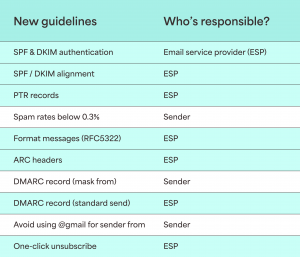Written by Force24 – regular exhibitor at marketingSHOWCASE
Google and Yahoo are gearing up to implement arguably the most significant policy updates in email history in February 2024, which will have company-wide impact spanning far beyond marketing campaigns
We’ve summarised the three crucial steps you need to take to ensure you’re prepared, plus get your free email deliverability assessment to see how you’re performing!
Customer engagement, sales conversions, brand reputation – all hang in the balance. In a rare joint statement released in October 2023, both companies outlined these forthcoming updates. The changes aim to penalise malicious actors by either slowing down their activity or outright blocking them.
Given that Google and Yahoo regulate the flow of numerous inboxes, it’s crucial for marketers to have the right systems in place. This ensures adherence to best practices, avoiding scenarios where emails end up in spam folders or, worse, get blocklisted.
For marketers who prioritise quantity over quality by employing a ‘batch-and-blast’ approach, these updates might be unnerving. However, for the majority of the marketing community, these changes represent a positive shift. Stricter policies serve to fortify the email ecosystem, safeguard recipients, and compel marketers toward best practices.
Now let’s get into it…
Implement DMARC!
DMARC (Domain-based Message Authentication Reporting and Conformance) stands as an email authentication protocol designed to protect domains from spoofing, phishing, and unauthorised activities. Google and Yahoo will further enforce stricter DMARC policies to curb spoofing and phishing attacks. Failure to demonstrate that your emails originate from an authorised or authenticated source might lead to email rejection or classification as spam.
Setting up DMARC ensures that legitimate emails successfully land in inboxes without being flagged. It establishes trust between your domain and the recipient’s mail server, signalling to Google and Yahoo that you are an authorised sender deserving inbox access.
To set up DMARC, generate a DMARC TXT record in your domain’s DNS settings (refer to http://dmarc.org for instructions). Once generated, add your DMARC TXT to your domain’s DNS configuration. Regularly monitor reports received from providers in the form of .xml files, adjusting DMARC policies and configurations to enhance your email authentication and security.
If you lack technical expertise in setting up DMARC, seek guidance from your Email Service Provider (ESP) or an IT professional.
Maintain a complaint rate below 0.3%
Minimising complaints is crucial to protect your sender reputation and brand credibility. The more complaints received, the less likely your emails will remain in recipients’ inboxes. Follow these best practices to reduce complaint rates…
- Obtain consent and set expectations early. You should obtain explicitly consent before emailing any contact. Avoid sending unsolicited emails or purchasing lists. After consent, assure recipients about data safety, share email intent clearly, and use recognisable sender names that reflect your brand.
- Provide clear unsubscribe options and keep your data clean. Ensure easy opt-out with visible unsubscribe links in every email for opted-in recipients. Regularly clean data by removing inactive subscribers and fixing invalid email addresses.
- Create personalised and relevant content. Tailor your emails to the individual interests and needs of each recipient, paying close attention to recipient feedback from direct replies and surveys. Avoid spam-triggering words/phrases in content and subject lines. Continuously optimise your communications strategy for better engagement.
- Comply with email regulations. Continue to adhere to email regulations and stay updated on laws. Consult your ESP if you’re unsure about compliance.
- Track your complaint rates with Google Postmaster Tools.
Assess your ESP against the upcoming policies
While ensuring your practices align with the upcoming policies is crucial, your ESP also shares responsibility. Initiate a conversation with your ESP to understand their compliance strategy and confirm they are actively making necessary adjustments to comply with the new guidelines. For a clear understanding of your responsibilities and those of your ESP, here’s a breakdown of each guideline:

In summary, you can prepare for the upcoming Google and Yahoo policy updates by taking three essential steps:
- Implement DMARC to secure your email domain and ensure inbox delivery. Visit http://dmarc.org for setup instructions.
- Maintain a complaint rate below 0.3% by following best practices: obtain consent, provide clear unsubscribe options, personalise content, and comply with email regulations.
- Assess your Email Service Prover’s (ESP) compliance with the new policies and discuss their strategy to align with the guidelines.
Written by Force24 – regular exhibitor at marketingSHOWCASE

